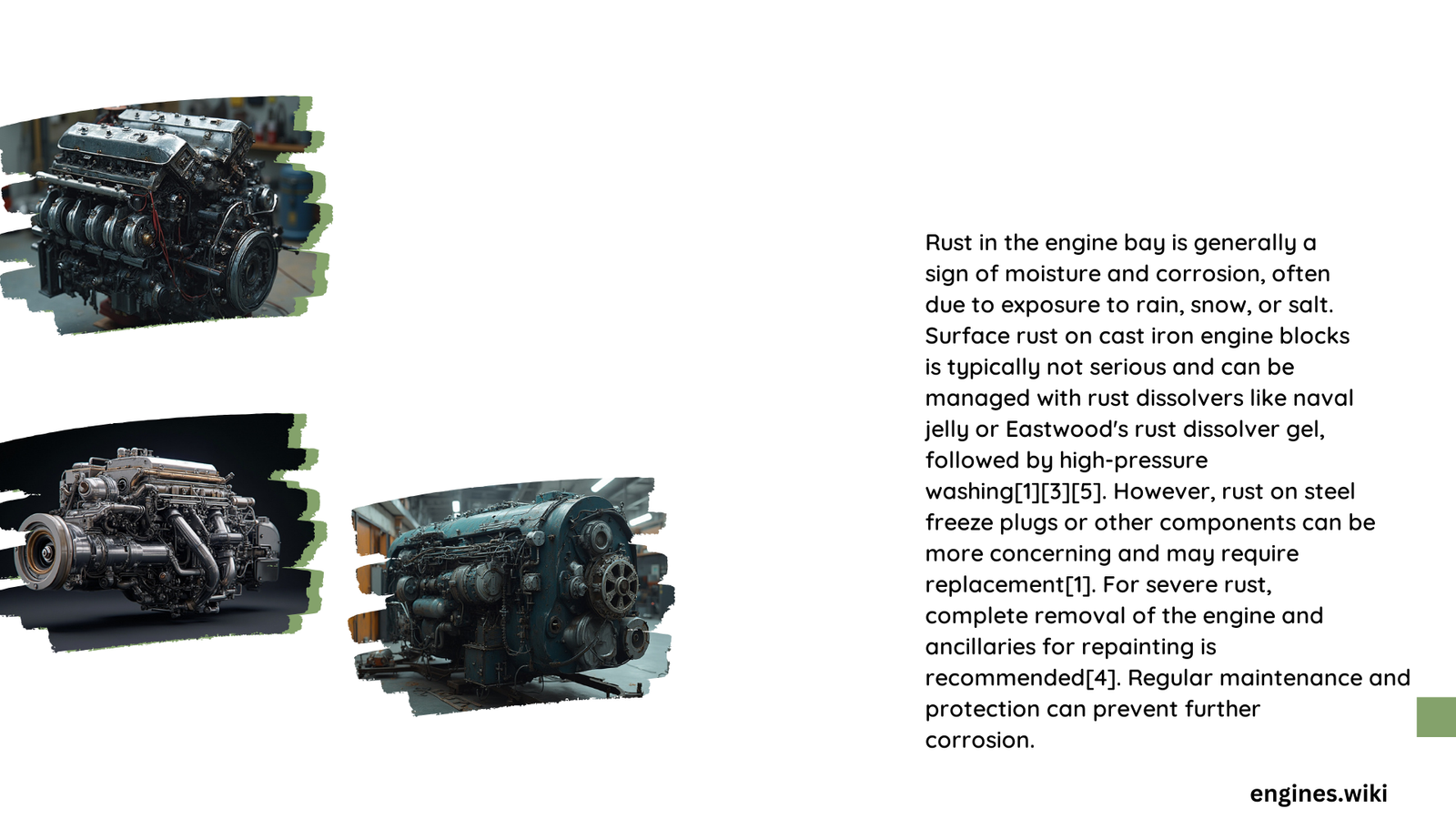Rust in the engine bay is a common issue that can significantly impact a vehicle’s performance and longevity. This corrosive process occurs when metal components in the engine compartment are exposed to moisture, oxygen, and other environmental factors. Left unchecked, rust can weaken critical parts, leading to mechanical failures and costly repairs. Understanding the causes, prevention methods, and removal techniques for rust in the engine bay is crucial for maintaining your vehicle’s health and value.
What Causes Rust Formation in the Engine Bay?
Rust formation in the engine bay is primarily driven by environmental factors and the materials used in vehicle construction. Here are the key contributors:
Environmental Factors:
- Moisture and humidity
- Salt and de-icing chemicals
- UV rays and extreme weather conditions
Materials Used:
- Ferrous metals (iron and steel)
- Non-ferrous metals (aluminum, magnesium)
Common Rust-Prone Areas:
- Undercarriage
- Wheel wells
- Engine components
- Fasteners and gaskets
How Can You Effectively Remove Rust from the Engine Bay?

Removing rust from the engine bay requires careful attention and the right techniques. Here are some effective methods:
Surface Rust Removal:
- Use high-grade sandpaper or abrasive wheel
- Apply rust remover or penetrating oil
- Prime and paint the affected area
Chemical Rust Removers:
- Apply phosphoric acid-based products
- Follow manufacturer’s instructions carefully
| Method | Time Required | Safety Precautions |
|---|---|---|
| Mechanical Removal | Several hours | Wear protective gear |
| Chemical Removal | 15-30 minutes per application | Ensure good ventilation |
What Are the Best Practices for Engine Bay Rust Prevention?
Preventing rust in the engine bay is crucial for maintaining your vehicle’s longevity. Here are some best practices:
Recommended Protective Coatings:
- Undercoating
- Ceramic seal coatings
- Rust inhibitors
Application Frequency:
- Regular washing: Weekly or bi-weekly
- Undercoating: Every 2-5 years
- Protective coatings: Annually or as recommended by the manufacturer
Environmental Conditions to Monitor:
- Humidity levels
- Salt exposure
- UV exposure
How to Conduct a Thorough Rust Inspection in the Engine Bay?
Regular inspections are key to catching rust early. Here’s how to conduct a thorough check:
Key Areas to Examine:
- Undercarriage
- Engine components
- Fasteners and gaskets
Signs of Early Rust Development:
- Paint bubbling
- Discoloration
- Small rust spots
Recommended Inspection Frequency:
- Every 6-12 months
- After winter season
What Are the Long-Term Effects of Untreated Rust in the Engine Bay?
Ignoring rust in the engine bay can lead to severe consequences:
- Structural weakening of components
- Reduced vehicle performance
- Increased fuel consumption
- Potential safety hazards
- Decreased resale value
How Does Climate Affect Rust Formation in the Engine Bay?
Climate plays a significant role in rust formation:
Coastal Areas:
- High salt content in the air accelerates corrosion
- Increased humidity levels promote rust
Cold Regions:
- Road salt and de-icing chemicals exacerbate rust formation
- Freeze-thaw cycles can create cracks, allowing moisture to penetrate
Hot and Humid Climates:
- High moisture levels speed up oxidation process
- UV rays can break down protective coatings
What Are the Most Effective Rust-Proofing Products for Engine Bays?
Several products can help protect your engine bay from rust:
- POR-15 Rust Preventive Coating
- Fluid Film Rust Inhibitor
- Rust-Oleum Rust Reformer
- CRC Heavy Duty Corrosion Inhibitor
- 3M Undercoating Spray
How Can You Differentiate Between Surface Rust and Structural Rust?
Understanding the difference is crucial for proper treatment:
Surface Rust:
- Appears as a reddish-brown discoloration
- Typically affects only the top layer of metal
- Can often be removed with sanding and treatment
Structural Rust:
- Penetrates deeper into the metal
- May cause flaking or bubbling of surrounding paint
- Often requires professional repair or part replacement
What Role Do Engine Bay Covers Play in Rust Prevention?
Engine bay covers can be an effective tool in rust prevention:
- Reduce exposure to environmental elements
- Minimize moisture accumulation
- Protect against UV damage
- Maintain a cleaner engine compartment
However, it’s important to ensure proper ventilation to prevent moisture buildup under the cover.
By understanding the causes of rust in the engine bay and implementing effective prevention and treatment strategies, you can significantly extend the life of your vehicle and maintain its performance. Regular inspections, proper maintenance, and prompt addressing of any rust issues are key to keeping your engine bay in top condition.
References:
1. https://getundrdog.com/blogs/detailing-blog/how-to-keep-rust-off-your-cars-paint
2. https://blisscarwash.com/car-corrosion-causes-and-effective-ways-to-prevent-it/
3. https://www.fleetmaintenance.com/in-the-bay/fluids-and-chemicals/article/21114415/steps-to-prevent-truck-body-and-component-corrosion-and-truck-rust
